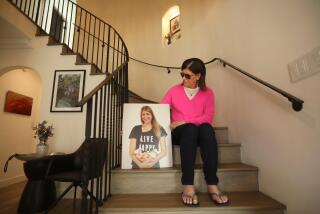Stigma of Ancient Disease Exacts Big Toll on Its Victims
Mary is determined not to cry as she talks about Hansenâs disease, but she keeps a box of tissues nearby, just in case.
Her condition, commonly known as leprosy, is not life-threatening. When treated, it is not contagious and has few visible symptoms, if any. But, since the 53-year-old Filipino immigrantâs illness was diagnosed nearly two years ago, she has discovered another common side effect: fear of rejection.
That fear is the reason she lies to her co-workers at a San Diego sporting goods company, explaining away the small dark spots on her face and arms as âallergies.â That same fear makes Mary ask a reporter not to print her real name and keeps her from telling her sister, who has a âweak heart,â about her battle with a disease that fills most people with dread.
âYou become an outcast--in the Philippines, you sure are one if you have this,â the tiny, dark-haired woman said recently, her delicate fingers folding and unfolding a tissue. âI have to tell a lie. Itâs not that I am ashamed. But I would like to protect my family. Nobody wants to have this.â
Mary is among a growing number of people--nearly 160 in all--who are fighting age-old stigmas at the Regional Hansenâs Disease Center in Pacific Beach. Housed in the countyâs North San Diego Public Health Center, the federally funded program is among 11 in the country established to care for Hansenâs patients--many of them Hispanic, Filipino or Southeast Asian immigrants--and their families. In the United States, Hansenâs disease--named for Armauer Hansen, a Norwegian physician who discovered its cause in 1873--remains quite rare. Only 6,000 of the worldâs 10 million known cases live in this country, mainly in California, Florida, Hawaii, Louisiana, New York and Texas. But, in San Diego, as in other regional centers in Los Angeles and San Francisco, the influx of immigrants from Mexico, Indochina and the Philippines continues to cause the caseload to swell.
That expansion comes despite the fact that Hansenâs disease, a bacterial infection that attacks the skin and nerves, is often mistaken for other things, from birthmarks to lupus. Because U.S. doctors rarely encounter the illness, many are unfamiliar with its symptoms--usually skin lesions and sensory loss. As a result, the average patient sees several doctors over about two years before getting an accurate diagnosis.
The San Diego clinic has two goals: In addition to providing medical care and counseling to patients in treatment, the four-person staff tries to increase medical professionalsâ âindex of suspicionâ about the disease so that new cases are detected sooner. And, although it canât change the world overnight, the staff encourages patients to start by erasing the word leper from their own vocabularies.
âLeper is like nigger-- educated people should not use the word,â said Dr. D. A. Lopez, a dermatologist and associate clinical professor at UCSD who has provided care to the areaâs Hansenâs patients since 1974. âItâs a type of phobia that society has. But (the word) does not describe the patient today.â
Today, Lopez explains, the legendary deformities of Hansenâs disease are completely preventable. Only 5% of the population is susceptible in the first place. And, for those who do get it, modern drugs can render the disease non-contagious, eliminating the need to separate people from their families in colonies, or leprosariums. Today, Lopez insists, virtually the only things that prevent people with Hansenâs disease from leading normal lives are societyâs misconceptions--and their own.
âLeprosy is not a threat to San Diego,â said Lopez, a retired Navy captain who first encountered the disease when he was assigned to the Navy Hospital in Balboa Park. âIn reality, thereâs nothing to fear from these people. Theyâre innocent victims caught between the germ and the body defenses. Their nerves get caught in the middle.â
Meredith, a North County resident in her 70s, remembers how frightened she was the day she bumped her leg against the sharp corner of a piece of furniture--and couldnât feel it. Born in the United States, she was not a high-risk candidate for Hansenâs disease. But she had recently been ill--her weakened system was the perfect host for an opportunistic infection. Whatâs more, over her lifetime she had lived off and on in an Asian country where she had had contact with Hansenâs patients.
Meredith, who also asked that her real name not be revealed, immediately suspected what doctors would later confirm. But she caught her Hansenâs early, started immediate treatment and avoided visible symptoms.
âIf you go to the clinic, thereâs really nothing to worry about,â she says now. In Asia, she recalled, âSome people really did suffer--open sores, they couldnât walk, their feet were bad. But it never needs to get that way.â
Finding treatment is the first hurdle. Keeping a positive outlook throughout what can be years of treatment is another. Despite the medical breakthroughs that address the physical symptoms, a diagnosis of Hansenâs takes a psychological toll. Some patients try to deny the problem, quitting their medicines at the first sign of improvement. Others are tightly wound with fear.
Carol Frank, the centerâs senior public health nurse, remembers one man who was improving, but for one thing: at the clinic, his blood pressure was always sky-high. When measured at home, however, it was normal. Finally, he admitted that visiting the clinic sent him into a tailspin--he was terrified that he would run into someone he knew.
Indeed, some Hansenâs patients opt to keep the condition secret, even from their spouses. For them, especially, the clinic becomes a vital part of survival. There, they can share their frustrations with the medicines, which often darken the skin. They can air their guilt and anger, or rehearse what to say to a loved one learning about Hansenâs for the first time.
As well as prescriptions, Frank makes sure the clinic dispenses plenty of physical affection, from handshakes to hugs. Many Hansenâs patients feel unlovable, betrayed by their bodies, she explains--especially those who have lost sensation (usually in the hands and feet) before treatment began.
âWe think pain is the enemy. But they get no input. Their self-image is lost,â said Lopez. âWhen sensation is gone, itâs a very lonely life.â
Hansenâs disease does not cause parts of the body to fall off, as many people believe. But, if not managed carefully, it can have other harmful effects. People with numbness in their extremities sometimes wear their shoes too tight, causing sores. They canât feel when their cigarettes burn too near their hands. Sometimes they pound their fingers with too much force, causing a shortening of the bones.
To avoid these potentially crippling problems, Hansenâs patients must overcome a natural tendency to regard their insensitive limbs as objects--a phenomenon best illustrated by the story, often repeated by Hansenâs specialists, of a man who helped with the cooking in his village by sticking his hands into hot coals to retrieve potatoes that fell off the grill.
âThey were utensils to him. They werenât his hands, they were more like a shovel or a spade,â said Frank. âPeople donât care about insensitive parts. They have to learn to love a part they canât feel.â Her advice to patients: âYou have to look at your hands and feet as your babies that canât cry.â
As well as maintaining a detailed regimen of self-examination, regular clinic visits and hygiene, patients must also learn how best to heal their psychic wounds and to brace for inevitable insults.
A few years ago, for example, one young patient at the clinic decided it would be best if he told his co-workers about his condition. He was fired. Frank told him his employerâs behavior was illegal, but the young man refused to return, opting instead to find another job. Efforts to debunk the myths surrounding Hansenâs disease are often thwarted by seemingly reputable sources. In most editions of the Bible, for example, the ghastly symptoms attributed to leprosy actually are a composite of a variety of diseases, from fungal infections to psoriasis. (The Hebrew word, zara âath , was translated âleprosyâ long before the modern usage of the term had restricted it to a single specific disease).
Whatâs worse, the Bible clearly suggests that leprosy is Godâs way of punishing sinners--a belief that clinic workers find they must regularly refute.
âThis is a germ, not the biblical disease,â Frank has explained again and again. But even for people of other faiths, the stigma is powerful. Frank says one young Cambodian boy refused treatment because, he said, âthatâs how Iâm supposed to be. This is punishment for past wrongs.â
Frightening Hollywood images depicted in film classics such as âBen Hurâ--pitiable hammer-footed souls with their wounds wrapped in gauze--donât help matters any. Neither do current movie previews, like one airing now for âThe Two Jakes,â in which Jack Nicholson describes the secret to his success like this: âIn this town, Iâm the leper with the most fingers.â
One-liners like that make Frank cringe--for every off-hand remark, she knows she will probably field scores of worried questions.
One woman whose daughter had sent her a handbag made by Hansenâs sufferers in Africa called the clinic. Would she get sick, she asked, if she slung it over her shoulder?
An agitated businessman expressed alarm when he received a fund-raising appeal in his morning mail from a leprosarium in the Philippines. He wanted to know if he should he keep his staff from touching it?
Frankâs response: Donât panic. Though technically Hansenâs Disease is an infectious condition, more than 90% of the population couldnât get it if they tried--especially not from a handbag. (Research scientists speculate that the disease is probably transmitted much like tuberculosis, through the upper respiratory tract.)
Doctors can also be ignorant. Lopez remembers completing his rounds one day in a San Diego hospital. Afterward, when he and his fellow physicians compared notes, Lopez told them he believed one patient they had seen had Hansenâs.
âOne doctor stood up, got pale, started perspiring and ran to wash his hands,â Lopez said. âThis kind of an impulse is automatic until we learn.â
Despite this ingrained prejudice, Lopez believes his patients will flourish if they fight the urge to retreat from the world. He discourages all but the most ill from getting disability classifications that allow them to park in handicapped parking spaces. He encourages them to take an active part in their own treatment and generally tries to squelch what he calls âthe âpoor me syndrome.â â
âI want them to think of themselves as (they would) other people,â Lopez said.
In that vein, visitors to the clinic could probably take a lesson from one long-time patient, a Mexican man in his 30s whose disease was diagnosed in 1982.
âI am a person who likes work, life . . . (I say) thank you for another day, thank you (that) I can walk, thank you that I can eat; in my mind, for me, I feel strong,â â he told Frank in a tape-recorded interview. âI know this Hansenâs is very, very strong and the problem for another person might be, âI canât do it.â (But) I can learn with being sick. I can live with the Hansenâs.â
For him, the first step to healing was choosing his words.
âThe skin specialist doctor said, âYour problem is Hansenâs,â â he said. âI never used â la lepra ,â because it is not necessary with my problem to use that word. . . . A lot of people would say, âDo you have la lepra ? OK, I canât touch.â â
Facts About Hansenâs Disease
* Known cases: 10 million worldwide. Of those, 6,000 live in the United States.
* Only 5% of the world population is susceptible, earning Hansenâs the title of the least infectious of the infectious diseases.
* In the U.S., most cases occur in foreign-born people.
* Symptoms: sudden loss of feeling in hands or feet; painful swelling or bumpiness of skin, especially on the face, hands and feet; loss of eyelashes or outer edges of eyebrows; earlobes swollen and turned out.
* Period between exposure and the onset of illness: six months to 20 years.
* There is no vaccine for Hansenâs disease and no test to determine if a person has been exposed. However, the disease is completely treatable with drug therapies.
Myths and Realities:
The myth: Hansenâs disease is caused by eating spoiled fish; by engaging too frequently in sex; by drinking tainted water.
The reality: Hansenâs disease is caused by Mycobacterium leprae, a bacterium that can infect the skin and nerves . Although it remains a mystery why some people are more susceptible to the disease, scientists believe it is an opportunistic infection that takes root when a personâs immune system is overloaded.
The myth: Hansenâs disease is a scourge delivered upon sinners by God.
The reality: In the Bible, the word âleprosyâ is used to describe the symptoms of a variety of diseases--a translation that has become outdated since the term now refers to a single, specific disease. Scientists see no link between the illness and immoral behavior.
The myth: Hansenâs disease causes parts of the body to fall off.
The reality: The most troubling development if the disease goes untreated is a gradual numbing of the extremities, which results in injuries sometimes going unnoticed. Injuries that become infected can lead to potentially crippling deformities. But, with care, these deformities are preventable.






